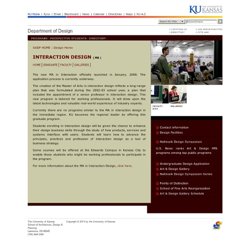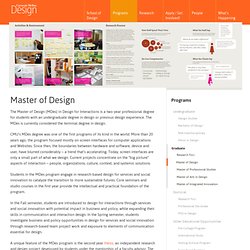

IxD - Human-Computer Interaction Design: Programs: Graduate: School of Informatics and Computing: Indiana University Bloomington. Our program is designed to change the way you think.

Human-computer interaction (HCI) has traditionally been the domain of engineering and psychology. Here, we approach it from the perspective of design. Our focus goes beyond simply using technology to solve a problem. It is about creating a technology experience that will be functional, intuitive, and even delightful for the people who use it. The goal of the human-computer interaction design (HCI/d) program is to teach you to think like a designer.
During your time here, you will refine your personal design philosophy through course work that: Teaches you the key history, literature, and research of HCI design (HCI/d)Introduces you to multiple frameworks, research techniques, and creative exercisesHelps you learn the skills necessary to use and design current and emerging applicationsExplores the socioeconomic consequences of implementing technologies in different cultures Questions? Degrees. IxD - Department of Design - Interaction Design. SADP HOME : Design Home The new MA in Interaction officially launched in January, 2008.

The application process is currently underway. The creation of the Master of Arts in interaction design reflects a long-range plan that was formulated during the 2002-03 school year, a plan that included the appointment of a senior professor in interaction design. This new program is tailored for working professionals. It will draw upon the latest technologies and valuable real-world experience of industry experts. Currently there are no programs similar to the MA in interaction design in the immediate region.
Students enrolling in interaction design will be given the chance to enhance their design business skills through the study of how products, services and systems interface with users. Some courses will be offered at the Edwards Campus in Kansas City to enable those students who might be working professionals to participate in the program. Random search - Interaction Design > School of Design > Carnegie Mellon University. The Master of Design (MDes) in Design for Interactions is a two-year professional degree for students with an undergraduate degree in design or previous design experience.

The MDes is currently considered the terminal degree in design. CMU’s MDes degree was one of the first programs of its kind in the world. More than 20 years ago, the program focused mostly on screen interfaces for computer applications and Websites. Since then, the boundaries between hardware and software, device and user, have blurred considerably – a trend that's accelerating. Today, screen interfaces are only a small part of what we design. Students in the MDes program engage in research-based design for services and social innovation to catalyze the transition to more sustainable futures.
In the Fall semester, students are introduced to design for interactions through services and social innovation with potential impact in business and policy, while expanding their skills in communication and interaction design. Random search - School of Visual Arts — MFA in Interaction Design. IxD - program overview. IxD - MIT Comparative Media Studies. IxD - Program. 3D Sensing and Visualization Seminar (ITPG-GT.2900) - Kyle McDonald Offered: Spring 2011, Fall 2012 This course will explore recent developments in 3d scanning technology and the tools and techniques for collecting, analyzing, and visualizing 3d data. Once relegated to the realm of academic and military research, 3d scanning has recently been made available to amateurs through DIY implementations like DAVID laser scanner, or, in the case of Kinect, through open source reverse engineering of cheap consumer hardware.
We will cover different methods of 3d input, including structured light, LIDAR, time of flight, stereo matching, and optical triangulation -- and focus on techniques for organizing and collecting data, creatively visualizing it, and using it in an interactive context. This course will be taught using openframeworks, a C++ toolkit for creative coding. This two-point course meets for the first seven weeks of the semester. Advanced Animation Studio (ITPG-GT.2923) - Eyal Ohana. Product Design & Strategy.